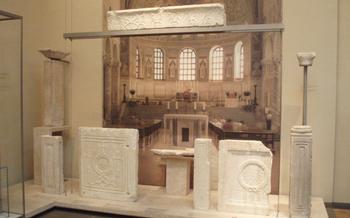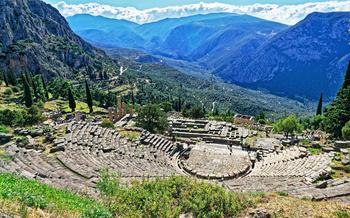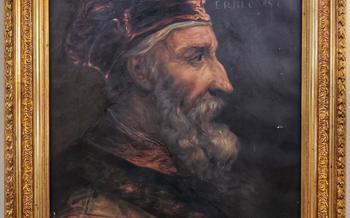
Archeological Museum of Komotini
- History of the Museum
- Location and Accessibility:
- Museum Architecture and Design
- Collection Highlights
- Prehistoric and Neolithic Artifacts
- Hellenistic and Roman Periods
- Byzantine and Medieval Artifacts
- Ottoman and Post-Ottoman Periods
- Temporary Exhibitions and Events
- Educational Programs and Workshops
- Visitor Services and Amenities
- Planning Your Visit
- Photo Opportunities and Social Media
- Local Cuisine and Dining Options
- Insider's Tip:
History of the Museum
The Archaeological Museum of Komotini stands as a testament to the rich cultural heritage and diverse history of the region. Its origins can be traced back to the early 20th century, when a group of dedicated archaeologists and scholars recognized the need to preserve and showcase the numerous artifacts unearthed during excavations in and around Komotini.
In 1953, the museum's doors officially opened to the public, marking a significant milestone in the preservation and promotion of the region's archaeological treasures. Over the years, the museum has undergone several renovations and expansions, reflecting its growing collection and the increasing interest in Komotini's rich past.
Through meticulous excavations conducted in the region, the museum has amassed a vast and diverse collection of artifacts that span various historical periods, from prehistoric times to the Ottoman era. These discoveries have played a pivotal role in shedding light on the cultural evolution of Komotini and its surrounding areas.
Location and Accessibility:
The Archeological Museum of Komotini is strategically located in the heart of the city, making it easily accessible to both locals and tourists. It is situated on Ethnikis Antistaseos Street, just a short walk from the central Omonia Square. Visitors can easily reach the museum by foot, exploring the charming streets and landmarks of Komotini along the way.
For those arriving by car, there are ample parking options in the vicinity, ensuring a hassle-free visit. Public transportation is also a convenient option, with bus stops located within walking distance of the museum. The Komotini Railway Station is also nearby, catering to travelers arriving by train.
The museum's proximity to other attractions, such as the picturesque Old Town, the Byzantine Fortress, and the Komotini Municipal Park, makes it an ideal starting point for exploring the city's rich cultural and historical heritage. Whether you're a history buff, an art enthusiast, or simply looking for a captivating cultural experience, the Archeological Museum of Komotini is a must-visit destination.
Museum Architecture and Design
The Archeological Museum of Komotini stands as a testament to modern architectural ingenuity, seamlessly blending contemporary design with respect for the region's rich history. Its striking exterior, characterized by clean lines and geometric forms, immediately captures the attention of visitors. The building's facade features expansive windows that allow natural light to flood the interior spaces, creating a bright and airy ambiance.
Upon entering the museum, visitors are greeted by a spacious and well-organized layout. The exhibition spaces are thoughtfully designed to guide visitors through a chronological journey of Komotini's past. Each section is clearly demarcated, allowing visitors to delve into specific periods or explore the entire collection at their own pace.
The museum's modern facilities and amenities enhance the visitor experience. Interactive displays, touchscreens, and multimedia presentations bring the exhibits to life, providing visitors with a deeper understanding of the artifacts and their historical context. Audio guides in multiple languages are available for those who prefer a self-guided tour.
Collection Highlights
The Archeological Museum of Komotini houses a remarkable collection of artifacts that shed light on the region's rich cultural heritage. Among the notable highlights are prehistoric stone tools and pottery, offering a glimpse into the earliest inhabitants of the area. Ancient pottery from the Bronze and Iron Ages showcases the artistic and technical skills of past civilizations.
Exquisite sculptures from the Hellenistic and Roman periods adorn the museum's halls, depicting gods, goddesses, and mythological figures with intricate details. A collection of coins and inscriptions provides valuable insights into the region's monetary system, trade, and political history.
Unique pieces like the "Head of Serapis," a marble sculpture from the Roman era, and the "Gold Ring of Komotini," featuring a delicate depiction of the goddess Tyche, set the museum apart. These artifacts symbolize the region's connection to the broader Hellenistic and Roman worlds.
The museum also boasts a significant collection of Byzantine and medieval artifacts, including Christian relics, icons, and jewelry, reflecting the area's rich religious and cultural heritage. Medieval pottery, weapons, and tools offer further evidence of the region's diverse cultural influences throughout history.
Prehistoric and Neolithic Artifacts
Journey through time as you explore the fascinating array of prehistoric and Neolithic artifacts housed within the Archeological Museum of Komotini. Discover the region's rich history as you marvel at stone tools, pottery, and figurines that offer a glimpse into the lives of early inhabitants. These relics provide valuable insights into the cultural development and technological advancements of the region during the prehistoric and Neolithic eras.
Among the most captivating artifacts are the intricately crafted stone tools, showcasing the remarkable skills and ingenuity of our ancestors. Admire the delicate pottery, adorned with intricate patterns and designs, hinting at the artistic expressions and creativity of the prehistoric communities. Small figurines, believed to have religious or symbolic significance, offer a glimpse into the spiritual beliefs and practices of the time.
As you examine these ancient treasures, imagine the hands that crafted them and the lives they touched. Each artifact tells a story, providing a tangible connection to the region's distant past. Delve into the origins of Komotini and gain a deeper appreciation for the foundations upon which its rich cultural heritage was built.
Hellenistic and Roman Periods
The Archeological Museum of Komotini houses a wealth of artifacts from the Hellenistic and Roman periods, offering visitors a glimpse into the region's rich cultural heritage. Sculptures, coins, and inscriptions from this era provide valuable insights into the Hellenistic influence on the region and its cultural significance.
Among the notable exhibits are marble and bronze sculptures depicting gods and goddesses, heroes, and mythological creatures. These exquisite works of art showcase the artistic prowess and craftsmanship of the Hellenistic period. Visitors can admire the intricate details and lifelike expressions captured in these sculptures, which offer a glimpse into the religious and mythological beliefs of the time.
The museum's collection of coins from the Hellenistic and Roman periods is equally impressive. These coins, minted in various cities across the region, feature diverse designs and symbols that shed light on the economic and political landscape of the era. Visitors can examine coins depicting rulers, deities, and city emblems, gaining insights into the monetary systems and trade networks that existed during this period.
Inscriptions on stone and metal provide further historical context and information. These inscriptions, ranging from official decrees to dedications to gods and individuals, offer glimpses into the administrative, religious, and social practices of the Hellenistic and Roman periods. Through these inscriptions, visitors can learn about the laws, customs, and daily lives of the people who inhabited the region during this time.
Byzantine and Medieval Artifacts
The Archeological Museum of Komotini houses a treasure trove of artifacts from the Byzantine and medieval periods, offering a glimpse into the region's rich cultural heritage during these times. Among the notable exhibits are exquisite Christian relics, intricate icons, and finely crafted jewelry, showcasing the artistic prowess and religious devotion of the Byzantine era. Medieval pottery, weapons, and tools provide insights into the daily lives and occupations of the inhabitants during this period. These artifacts collectively demonstrate the enduring influence of Byzantium and the significant role Komotini played within the Byzantine Empire.
Ottoman and Post-Ottoman Periods
The Archeological Museum of Komotini houses a collection of artifacts that shed light on the Ottoman period, which lasted for over 500 years, and the subsequent post-Ottoman era. During Ottoman rule, the town underwent significant changes, including the construction of mosques, baths, and other Islamic architecture. The museum showcases artifacts such as pottery, metalwork, and textiles that reflect the town's transformation under Ottoman rule.
The post-Ottoman period marked a time of transition for Komotini, as it was incorporated into modern Greece. The museum presents artifacts from this period, including documents, photographs, and everyday objects that illustrate the challenges and changes faced by the town's inhabitants during this time. Visitors can gain insights into the region's cultural heritage and the diverse influences that have shaped Komotini's identity over the centuries.
Temporary Exhibitions and Events
The Archeological Museum of Komotini actively engages in hosting temporary exhibitions and events throughout the year. These special exhibitions often focus on specific themes or periods of history and culture, providing visitors with a deeper dive into the region's rich heritage. The museum collaborates with other institutions and organizations to showcase diverse perspectives and artifacts. These events offer a dynamic and interactive way for visitors to connect with the museum's collection. Temporary exhibitions not only expand the museum's offerings but also attract a broader audience, fostering cultural exchange and stimulating intellectual curiosity. By participating in these events, visitors can gain a comprehensive understanding of the region's history and its significance in the broader context of Greek and European culture.
Educational Programs and Workshops
The Archeological Museum of Komotini is committed to fostering knowledge and appreciation of the region's cultural heritage. To this end, it offers a range of educational programs and workshops tailored to students, groups, and visitors of all ages.
For school groups, the museum provides guided tours that bring history to life, allowing students to engage with the artifacts and learn about the region's past in an interactive and engaging way. These tours are designed to align with school curricula, ensuring that students gain valuable insights into various historical periods.
The museum also organizes workshops, lectures, and demonstrations that delve deeper into specific aspects of archaeology and history. These events are open to the public and provide an excellent opportunity for visitors to learn from experts in the field.
Through these educational initiatives, the Archeological Museum of Komotini plays a vital role in promoting knowledge and understanding of the region's rich cultural heritage, inspiring future generations to become passionate about history and archaeology.
Visitor Services and Amenities
The Archeological Museum of Komotini is committed to providing a welcoming and enriching experience for all visitors. To enhance your visit, the museum offers a range of services and amenities that cater to diverse needs and interests.
- Guided Tours:
-
Discover the museum's treasures with knowledgeable guides who bring history to life. Guided tours are available in various languages upon request, ensuring that international visitors can fully appreciate the museum's collection.
-
Audio Guides:
-
Immerse yourself in the stories behind the artifacts at your own pace with the museum's audio guides. These devices provide detailed information in multiple languages, allowing you to explore the exhibits in-depth.
-
Museum Shop:
-
Take a piece of Komotini's rich history home with you from the museum shop. Browse a carefully curated selection of souvenirs, books, and educational materials that celebrate the region's cultural heritage.
-
Accessibility Features:
- The Archeological Museum of Komotini is dedicated to ensuring accessibility for all visitors. Wheelchair ramps, elevators, and accessible restrooms are available throughout the museum, making it easy for everyone to navigate and enjoy the exhibits.
Planning Your Visit
To fully appreciate the treasures housed within the Archeological Museum of Komotini, it is recommended to allocate at least two to three hours for your visit. This will allow you ample time to leisurely explore the various exhibits and delve into the rich history and culture of the region.
Plan your visit during the museum's operating hours, which are typically from 8:00 AM to 3:00 PM on weekdays and from 9:00 AM to 3:00 PM on weekends. Keep in mind that the museum is closed on Mondays. To avoid crowds and ensure a more intimate experience, consider visiting during the off-season or on a weekday morning.
For a comprehensive and immersive experience, take advantage of the guided tours offered by the museum. These tours are led by knowledgeable experts who will provide insightful commentary and anecdotes, bringing the exhibits to life. Alternatively, you can opt for an audio guide, which will allow you to explore the museum at your own pace while still gaining valuable information about the artifacts.
To make the most of your time in Komotini, combine your visit to the Archeological Museum with other attractions in the city. The museum's central location makes it easy to explore other landmarks, such as the Komotini Castle, the Old Town, and the historic churches. Plan an itinerary that allows you to immerse yourself in the cultural and historical tapestry of this vibrant city.
Photo Opportunities and Social Media
The Archeological Museum of Komotini offers a treasure trove of photo opportunities for visitors who love to capture their travel memories. From the imposing facade of the building to the intricate details of the artifacts on display, there are countless moments worth preserving. The museum's well-lit exhibition spaces and carefully arranged displays provide ample opportunities for capturing stunning shots.
Don't miss the chance to immortalize your visit to the museum by snapping a photo with the impressive collection of ancient sculptures as your backdrop. The intricate carvings and lifelike expressions of these works of art will add a touch of grandeur to your social media feed.
For a unique perspective, head to the museum's outdoor areas, where you can capture the harmonious blend of history and nature. The lush gardens and courtyards provide a serene setting for capturing photos that showcase the museum's architectural beauty.
To connect with the museum's online community and share your experiences, use the hashtags #ArchaeologicalMuseumofKomotini and #KomotiniMuseum. By geotagging your photos, you'll be part of a vibrant community of travelers and history enthusiasts who are passionate about exploring Greece's rich cultural heritage. So, don't forget to capture your visit to the Archeological Museum of Komotini and share your memories with the world!
Local Cuisine and Dining Options
Komotini is a haven for foodies, offering a vibrant culinary scene that blends traditional Greek flavors with local influences. To enhance your visit to the Archeological Museum, consider exploring the nearby restaurants and cafes and indulging in the region's delectable cuisine.
For a taste of authentic Greek dishes, head to To Steki tou Ilia, located just a short walk from the museum. This charming taverna serves up classic dishes such as moussaka, pastitsio, and souvlaki, all prepared with fresh, local ingredients.
If you're in the mood for something lighter, To Kafeneion tis Kyrias Eleni offers a variety of meze (small plates) and traditional Greek coffee. Sample the delicious spanakopita (spinach pie), keftedes (meatballs), and dolmades (stuffed grape leaves) while enjoying the warm ambiance of this local gem.
For those with a sweet tooth, To Glykopoleio tou Kiriakou is a must-visit. This traditional Greek pastry shop offers an array of mouthwatering desserts, including baklava, kataifi, and galaktoboureko. Pair your sweet treat with a cup of Greek coffee or a refreshing glass of lemonade for the ultimate indulgence.
Remember to save room for some of Komotini's famous dairy products, such as yogurt, cheese, and butter, which are known for their rich flavor and high quality. Whether you choose to dine at a traditional taverna or grab a quick bite at a local cafe, Komotini's culinary delights are sure to tantalize your taste buds and create lasting memories of your visit.
Insider's Tip:
The Archeological Museum of Komotini is a treasure trove of hidden gems waiting to be discovered. Look out for the enigmatic "Smiling Sphinx" sculpture from the Hellenistic period, which is believed to possess magical powers. It is said that if you make a wish while gazing into its eyes, your desire will be granted. Don't miss the annual "Night at the Museum" event, held every summer, where the museum comes alive with music, performances, and guided tours under the stars. And if you're lucky, you might catch a glimpse of the museum's resident ghost, a friendly spirit known as "The Curator", who is said to roam the halls, ensuring that the treasures of the past are well-preserved for future generations.



